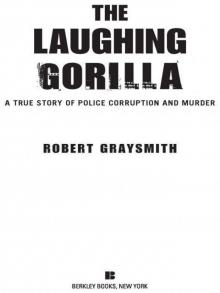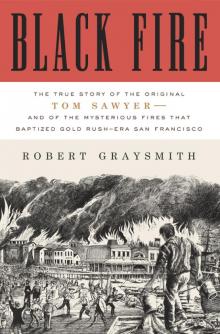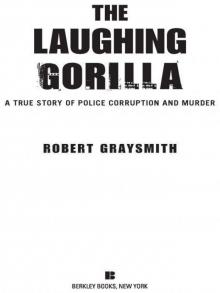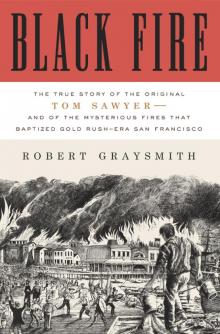- Home
- Robert Graysmith
Black Fire: The True Story of the Original Tom Sawyer
Black Fire: The True Story of the Original Tom Sawyer Read online
Also by Robert Graysmith
Zodiac
The Sleeping Lady
Auto Focus: The Murder of Bob Crane
Unabomber: A Desire to Kill
The Bell Tower
Zodiac Unmasked
Amerithrax: The Hunt for the Anthrax Killer
The Laughing Gorilla
The Girl in Alfred Hitchcock’s Shower
Copyright © 2012 by Robert Graysmith
All rights reserved.
Published in the United States by Crown Publishers, an imprint of the Crown Publishing Group, a division of Random House, Inc., New York.
www.crownpublishing.com
CROWN and the Crown colophon are registered trademarks of Random House, Inc.
Library of Congress Cataloging-in-Publication Data
Graysmith, Robert.
Black fire: the true story of the original Tom Sawyer—and of the mysterious fires that baptized Gold Rush–era San Francisco / written and illustrated by Robert Graysmith. — 1st ed.
p. cm.
Includes bibliographical references.
1. Sawyer, Tom, 1832–1906. 2. San Francisco (Calif.)—Biography. 3. San Francisco (Calif.)—History—19th century. 4. Adventure and adventurers—California—San Francisco—Biography. 5. Firefighters—California—San Francisco—Biography. 6. Fires—California—San Francisco—History—19th century. 7. Arson—California—San Francisco—History—19th century. 8. Twain, Mark, 1835–1910—Friends and associates. 9. Sawyer, Tom (Fictitious character) 10. Twain, Mark, 1835–1910—Sources.
I. Title.
F869.S353S294 2012
979.4′04092—dc23
[B]
201200313
eISBN: 978-0-307-72058-0
Illustrations by Robert Graysmith, except the historical images appearing on 3.1, 6.1, 8.1, 9.1, from the collection of Robert Graysmith
Cover design by Christopher Brand
Cover illustration by Robert Graysmith
v3.1
IN MEMORY OF GAVIN
“You want to know how I come to figure in his books, do you?” Sawyer said. He turned on his stool, acknowledged the reporter, raised his brandy and took a sip. They were speaking of Twain, of course. “Well, as I said, we both was fond of telling stories and spinning yarns. Sam, he was mighty fond of children’s doings and whenever he’d see any little fellers a-fighting on the street, he always stop and watch ’em and then he’d come up to the Blue Wing and describe the whole doings and then I’d try and beat his yarn by telling him of the antics I used to play when I was a kid and say, ‘I don’t believe there ever was such another little devil ever lived as I was.’ Sam, he would listen to these pranks of mine with great interest and he’d occasionally take ’em down in his notebook. One day he says to me: ‘I am going to put you between the covers of a book some of these days, Tom.’ ‘Go ahead, Sam,’ I said, ‘but don’t disgrace my name.’ ”
—VIOLA RODGERS, INTERVIEW WITH TOM SAWYER,
SAN FRANCISCO CALL, October 23, 1898
CONTENTS
Cover
Other Books by This Author
Title Page
Copyright
Dedication
Epigraph
Author’s Note
Dramatis Personae
Prologue
Part I: THE MAN WHO BURNED DOWN SAN FRANCISCO
December 24, 1849–September 16, 1850
Chapter 1
Broderick and the Christmas Eve Catastrophe
Chapter 2
Sawyer
Chapter 3
Sleeprunners and Flying Houses
Chapter 4
Broderick’s Rogues
Chapter 5
Rainbow Rivers of Gold and Silver
Part II: THE LIGHTKEEPER
September 17, 1850–June 22, 1851
Chapter 6
Tug-of-War
Chapter 7
The Melting House
Chapter 8
The Lodger
Chapter 9
The Golden Ring
PART III: STEAMING WITH TWAIN AND SAWYER
May 26, 1863–December 16, 1866
Chapter 10
Steamers
Chapter 11
The Fire Girl
Chapter 12
Let Us Build a City
Sources and Acknowledgments
Selected Bibliography
About the Author
AUTHOR’S NOTE
Black Fire is the first book about Tom Sawyer, a bona fide San Francisco hero and poker-playing buddy of Mark Twain’s, and his relationship with Twain, who, in 1863, was considering a first novel. In 1864, Twain began to envision a book of much wider scope as he heard more of Sawyer’s incredible adventures a dozen years earlier in a landscape of burning roads, melting iron warehouses, mystery men and deadly gangs who extorted and ruled by fear. This is the true story of the volunteers; their band of boy firefighters, the torch boys; a U.S. senator; the World Heavyweight Champ; the most famous bruiser of the era; a lethal gunfighter; and fifty or sixty other misfits as they hunted a mysterious serial arsonist who, in 1849–51, would burn San Francisco to the ground six times in eighteen months. All the characters are real and their dialogue is based on letters, personal diaries, journals, memoirs, biographies, historical records, published newspaper interviews, public speeches, civil and criminal trials, illegal Vigilance Committee tribunals, transcripts and confessions, and original 1850–51 history volumes. In an 1895 interview Twain said he did not believe an author ever lived who had created a character, that characters are always drawn from someone the writer has known. “We mortals can’t create, we can only copy,” he said. He wanted Tom Sawyer to be the boy who carried on the nation’s soul. In 1850, America was San Francisco.
—ROBERT GRAYSMITH
SAN FRANCISCO, CALIFORNIA, NOVEMBER 2011
DRAMATIS PERSONAE
The Protagonists
Clockwise, from left: Mark Twain: San Francisco Call reporter in search of his first novel; Tom Sawyer: veteran volunteer fireman, customs inspector, and savior of ninety lives at sea; Eliza “Lillie” Hitchcock: a volunteer fire girl and potential subject of Twain’s first novel; U.S. Senator David C. Broderick: chief of San Francisco’s first volunteer fire company; Bret Harte: Mark Twain’s writing partner and a rival for Lillie Hitchcock’s favors
Broderick’s Crash Squad of Faithful Bully B’hoys
Charles P. “Dutch Charley” Duane: the biggest, toughest brawler of the Gold Rush era; Billy Mulligan: a lethal, diminutive gunfighter with a chip on his shoulder; James “Yankee” Sullivan: former World Heavyweight Champ and the “Ugliest Man in San Francisco”
The Antagonists
Clockwise, from top left: Sam Brannan: the city’s first millionaire and one of the bad old town’s greediest men; Davey Scannell: “Prince of Rogues” and Sawyer’s rival; The Lightkeeper: an unknown serial arsonist who burns down San Francisco six times in eighteen months
An arsonist was loose in 1850 San Francisco.
Whirlwinds of hot air spiraled around Tom Sawyer and the volunteer firefighters, then united to create a huge vortex. The giant ring rose above them. When directly overhead, the invisible ring of superheated air slowly began to turn clockwise. Gradually it took on the hue of the fire and became a golden ring. It spun faster until it created an updraft rising miles into the stratosphere. The center of the ring, hotter still, ate up all the oxygen to create a counterclockwise downdraft of sparks and lethal gases that was forced onto Sawyer and a ragtag group of boys, some as young as eight. As the inner ring rotated, it bec
ame a dark circle of smoke.
At the fire’s center a hailstorm of burning embers flurried clockwise on the superheated wind. Burning coals rained down on the men. Sparks rose in the shifting gale. Highly disciplined soldiers and sailors, covered with soot, hauled kegs of black powder to buildings standing in the fire’s path. Blasts more awful than the blaze shook the city and rose above the fire’s monotonous roar. Terrified animals fled along the streets before the explosions. Houses leaped skyward. Sawyer held a moistened finger aloft. “The wind is altering its course,” he called to the volunteers. “Yes, the gale’s moving northward. We might be spared yet. The main district might not be lost entirely. The next hour will tell.” But he knew the battle was hopeless.
Undeterred, the volunteers went on pulling down houses in the path of the fire to stay it. Tornadoes of flames and smoke columns walked alongside the haggard men, running clockwise and counterclockwise, creating additional whirlwinds that carried sparks miles away to start new fires. In the choking smoke the volunteers’ breathing came in gasps as they rushed blindly searching for safety. Washington, Bush, and Sansome streets were thundering furnaces. The Lightkeeper, as some had named the firebug because he always struck when the Lightkeeper’s Wind was rushing away from the encampment of ex-convicts on the slopes of Telegraph Hill, would burn San Francisco to the ground six times in eighteen months, the most disastrous and costly series of fires ever experienced by any major American metropolis. As Sawyer fought the flames, he wondered what the Lightkeeper’s motive was. Surely he must have one, if only to watch their hopeless battle against black fire, the most dangerous kind, produced when a heavy mix of fire gases under great pressure accumulate within a fire-involved structure and erupt at high velocity into boiling mushrooms of superheated black smoke and rapidly advance toward a hot, rich flashover. Firemen say it’s “all the bad things come together at once.”
The city’s boundless hills, sand mountains, and valleys, its high, narrow streets filled with confusing echoes that carried for miles, made any fire impossible to find. During the volunteers’ urgent missions in the twisting ravines, they dared not become lost. Thus, when darkness fell, Sawyer led his ragtag corps of torch boys ahead of their hand-drawn engines to light the way over the hazardously pitted, unlit, and fogbound roadways. They carried fire to the fire, a very poetic occupation.
Sawyer studied the pumping and chopping firefighters of the company called Broderick One around him. It took rugged brawlers to haul a one-ton water-filled engine up the steep hills of Gold Rush San Francisco, including a senator, a lethal gunfighter, a master con man, the Ugliest Man in California, the World Heavyweight Champ, and fifty other street toughs and dandies, but it was left to Sawyer and his contingent of lightning-swift runners to unravel the Lightkeeper’s identity. As if to aid the arsonist, the townsfolk slathered every jammed-together card house of oilcloth walls, white muslin floors, and canvas roofs with inflammable paint; they thrust blow pipes through tarred roofs and pumped cinders through defective flues.
The blaze rumbled westward and northeastward at the same time. The wind changed and filled the fire with oxygen. The fire’s sound changed to that of a locomotive rumbling over broken tracks. Sawyer was amazed that smoke could roar. The torch boys led the men of Broderick One Company through shortcuts and down seldom-used alleyways. The blaze swept toward them—a momentary darkening, then a gush of sparks followed by superheated air, dense gases, and a broad column of fire that shrouded everything with red.
There was no escape.
Mark Twain at 30 years
Mark Twain and Tom Sawyer steaming
PROLOGUE
It was the first time Tom Sawyer had ever seen Mark Twain looking glum. Sawyer studied the journalist—loose-jointed body; coarse tumble of fiery hair; long, black, lethal-looking cigar; and “soup-strainer” mustache. A rangy, lanky man, Twain did not really walk, but ambled and slouched his way through the muddy streets and back alleys of San Francisco. His normal dress was careless and disheveled. His clothes were unbrushed and freckled with tobacco, though at this moment he was nude, his chest a forest of matted hair, with one leg lolling from the arm of a chair. Twain’s eyes glared like an eagle’s beneath ranging, sopping brows.
On this rainy afternoon in June 1863, he was nursing a bad hangover inside Ed Stahle’s fashionable Montgomery Street steam rooms halfway through what was intended to be a two-month visit to San Francisco that would stretch to three years. The sleepwalking and melancholic journalist regularly went to the Turkish baths to sweat out any dark thoughts of suicidal temptation, which were not uncommon. At the baths he played penny ante with the proprietor, Ed Stahle, and Sawyer, the recently appointed customs inspector, volunteer fireman, special policeman, and bona fide local hero.
In the clouds of boiling steam, Sawyer was mending his own wounds, though his were from a nearly fatal ordeal onboard a burning steamboat a decade earlier. In contrast to the lanky Twain, Sawyer, three years older, was a stocky, round-faced mesomorph. His sleepy blue eyes were comfortable to gaze into. His hair was a disordered haystack, a dark brown shock with sideburns. His chest was hairless and his body, smooth and well muscled, was without definition, though he could heft two men easily. In comparison to Twain’s remarkable soup-strainer, his mustache and goatee were unimpressive. Sawyer was not completely nude; he wore a coat of smoke and soot that, as the three men played poker, the hot steam gradually washed away. Beneath their bare feet coursed an ancient secret tunnel and under that a huge raft upon which the massive four-story granite building floated. Two doors down was Hotaling’s distillery, two doors up was the old gold-weighing station and a block away was the bloodstained ground of “Murderer’s Corner,” where men were hanged.
In early May, Twain had departed Virginia City for a two-month visit to San Francisco to visit Bill Briggs, the handsome brother of John Briggs, a close friend in Hannibal, and Neil Moss, a former classmate. Twain habitually passed hours at Stahle’s posh ground-floor barbershop and basement steam baths on Montgomery Street, a thoroughfare he likened to “just like being on Main Street in Hannibal and meeting the old familiar faces.” The extensive chunk of granite known as the Montgomery Block dominated the southeast corner of Montgomery and Washington streets, numbers 722 and 724 Montgomery Street. It had been a Gold Rush tobacco warehouse, the Melodean Theatre, and now the Turkish bath where Twain parboiled with fireman Sawyer and Stahle, another good friend. Twain studied his cards and hefted a bottle of dark beer. It was cold and sweaty in his palm. He took a swig. A few glistening droplets caught in his horseshoe mustache and he left them there. He slumped as he played poker, smoking one of the Wheeling “long nines,” which reportedly could kill at thirty yards. He had become addicted to them while a cub pilot on the Mississippi. Puffing, he contributed his own clouds to the roiling steam. Twain bought the long, disgusting licorice-flavored ropes by the basketful for a dime and by the barrel for four dollars (including the barrel). For his guests he bought the long nines in disreputable, square pasteboard boxes of two hundred. He awoke two or three times a night to smoke. He held his cigar poised in the air, took a few heroic whiffs, and scattered the vapor with a long sweep of his arm.
Twain had acquired a taste for steam baths at Moritz’s Bath House in Virginia City and, while laboring under bronchitis and a serious cold, at the recently discovered mineral waters of Steamboat Springs, eight miles northwest on the Geiger Grade, the road between Virginia City and Steamboat Springs, a distance of seven miles. Over the first of a long line of nine beautiful steam columns, Nevadans had constructed a large house to bathe in. Twain likened the jets of hot white steam emitted from fissures in the earth to a steamboat’s escape pipes. They made a boiling, surging noise exactly as a steamboat did. He enjoyed placing eggs in his handkerchief to dip them in the springs, soft-boiling them in two minutes or hard-boiling in four, depending upon his mood.
Sawyer luxuriated in the hot mist and surveyed his cards, murky in the haze. The pastebo
ards were damp from the sweat running down the players’ arms, but the fresh bottles of German beer Stahle had had sent in were cold. In his thirty-two years Sawyer had been a torch boy in New York for Columbia Hook and Ladder Company Number Fourteen, and in San Francisco he had run before the engines and battled fire for Broderick One, the city’s first volunteer fire company, under Chief David Broderick, the first fire chief. Twain, who held strong opinions on steamers, perked up when Sawyer mentioned he had toiled as a steamboat engineer plying the Mexican sea trade. The journalist had cautioned any bold boy who dreamed of shipping as a steamer fireman. “Such a job,” he would say knowingly with a waggle of his finger, “has its little drawbacks.” In Stahle’s boiling steam room he pointed out the suffocating temperature of the furnace room where the engineer stands in a narrow space between two rows of furnaces that “glare like the fires of hell … he shovels coal for four hours at a stretch in an unvarying temperature of 148 degrees Fahrenheit! Steamer firemen do not live [on average] over five years!”
Sawyer had survived twice that long because he was a fireman in every sense of the word. He extinguished fires and stoked fires to fury; he knew furnaces and every aspect of perfect combustion intimately. “The stronger the draught, the thicker the fire should be,” he explained, his face lighting up in the clouds of steam as he warmed to his topic. “If the fire’s thickness is kept even and no hollow places are allowed to form in it, the furnace temperature gradually increases until at a certain breadth the fuel reaches a state of brilliant white incandescence.” Sawyer could tell temperature by the coal’s color to within a few degrees. Dull red meant 1290 degrees Fahrenheit, cherry red indicated 1470 degrees, deep orange meant the temperature exceeded 2000 degrees, and white signaled a blaze of 2370 degrees. Dazzling white meant the temperature was climbing beyond the limits of the iron boiler and had to be damped down.

 The Laughing Gorilla: A True Story of Police Corruption and Murder
The Laughing Gorilla: A True Story of Police Corruption and Murder Zodiac Unmasked: The Identity of America's Most Elusive Serial Killer Revealed
Zodiac Unmasked: The Identity of America's Most Elusive Serial Killer Revealed Black Fire: The True Story of the Original Tom Sawyer
Black Fire: The True Story of the Original Tom Sawyer Zodiac Unmasked: The Identity of America's Most Elusive Serial Killers Revealed
Zodiac Unmasked: The Identity of America's Most Elusive Serial Killers Revealed The Laughing Gorilla
The Laughing Gorilla Black Fire
Black Fire